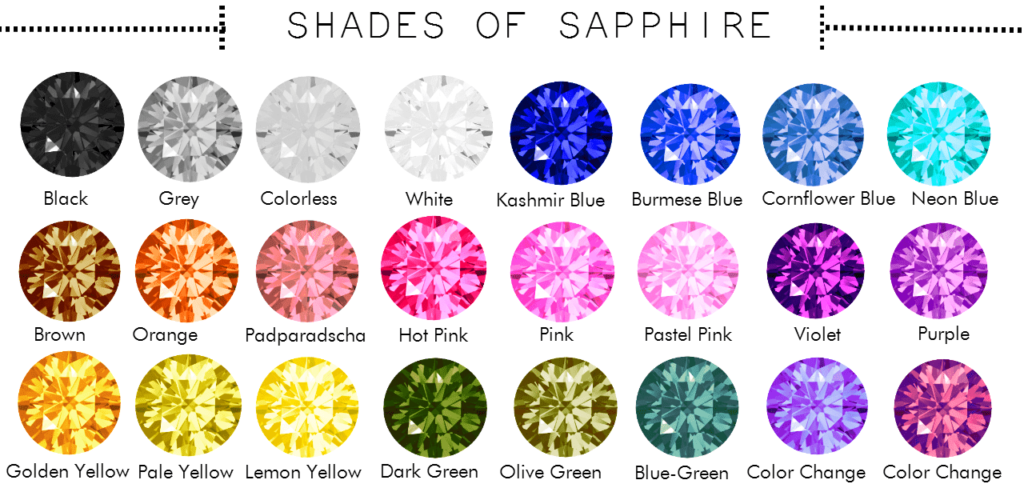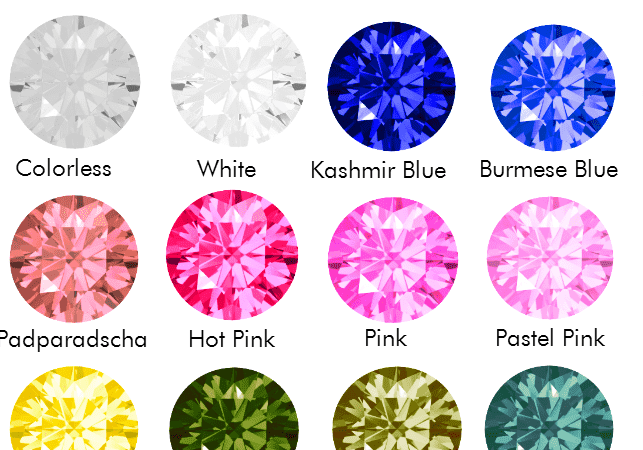The Rarest Colors Of Natural Sapphires
Time and again, sapphires have surprised us with their ability to be available in every color imaginable. Quite possibly, sapphires can be named Nature’s Color Chart! While color makes for the most important factor in the valuation of sapphires, the other 3 C’s: Color, Clarity, and Cut play a significant role in the emergence of the true brilliance of the color.

As a rule of thumb, apart from red corundum (which is called ruby), blue sapphires, and colorless sapphires, all other colors in sapphires are termed as fancy sapphires. Many of these colors have proprietary names and the same color can be called differently around the world. Let us explore the most exciting and unique shades in this beautiful gemstone.
1. Teal and Mermaid Sapphires:
The perfect union of the earth and sea, teal sapphires are a combination of enchanting blues and mesmerizing greens. The most valuable form of teal sapphires is the mermaid sapphires that are an exact 50-50 ratio of blue and green chilies, making them reminiscent of a mermaid’s scales. I’m other variants, one may find bits of yellow and space grey colors. The largest source of teal and Mermaid Sapphires today is Australia, followed closely by Montana. Some other sources are Nigeria, Madagascar, and Sri Lanka. Since the largest sources of both teal and Mermaid Sapphires are Australia and Montana where mining is done mechanically, these have become synonymous with ethical sourcing and are popular as “green stones.”
(Note the color difference between a teal sapphire of a darker hue (Above) and a mermaid sapphire (Below). The below image is of a stunning step cut oval 6.11-carat mermaid sapphire)
View this post on Instagram
2. Parti Sapphire:
Parti sapphires derive their name from the term “partition” as there is a zone of demarcation between the two colors. Parti sapphires can be found in a number of combinations, the most common being blue and green due to which they are frequently confused for teal or mermaid sapphires. However, on examination, the color difference is extremely evident as there is a clear zone of demarcation between the two colors in parti sapphires (color zoning), whereas the two colors blend into each other with the latter. This buyer’s guide to parti sapphires explains more in-depth about these beautiful gemstones.


View this post on Instagram
3. Padparadscha Sapphires:
With their unique blend of sunset orange and lotus pink, Padparadscha sapphire from Sri Lanka is a collector’s dream. What adds to its mystique is that it’s a single source gemstone that is unique to Sri Lanka and cannot be found anywhere else in the world. The beautiful greenstone is sometimes also classified either under peach sapphires or pink sapphires, depending upon the preceptor’s classification. However, the most valuable type of Padparadscha sapphire is the one with 50% orange and 50% pink colors.

4. Color Changing Sapphires:
The property of pleochroism permits the appearance of “color-changing” in different lighting conditions. Color-changing sapphires typically appear bluish-violet in daylight conditions or under fluorescent LED lights. Under incandescent light, they appear strongly violet-purple or reddish-purple. A rare variety appears green in daylight and reddish-brown in incandescent light. Color-changing sapphires can be classified as weak, moderate, and strong and this property determines the value of the stone.
5. Star Sapphires:
Star sapphires occur due to the property of asterism in which tiny inclusion particles reflect light in certain directions when cut in a certain way. While 6 rayed star sapphires are the more common variety, 12 rayed stars are rarer. Start sapphires are cut as cabochons to display asterism. During cutting the star must be centered on top of the stone, workout the waves being broken of fuzzy and the star should appear to move smoothly over the surface of the stone when the stone is rocked.

6. Cognac sapphires:
A recent favorite amongst jewelry designers, the deep earthy undertones of cognac sapphires have become a huge favorite. While the term is used interchangeably with brown sapphires, a distinct reddish undertone marks the difference between the two, making cognac sapphires rare and much more expensive than brown sapphires. Quality cognac sapphires are mined in Australia, Sri Lanka, Thailand, and Madagascar.
7. Pink and Violet sapphires:
Traditionally sapphires are revered in the blue color but the turn of the century saw the movie fraternity picking up on interesting colors like the hot pink sapphire color. Ever since pink and violet tones of sapphires have been extremely popular for their feminine inclination. While lighter pink and violet tones are usually preferred by the younger crowd, possibly because of their affordability, vivid tones remain an expensive and choice option.

8. Green sapphires:
Strictly speaking, green sapphires are not particularly expensive or rare except for one variety; a uniform green color without a hint of yellow or blue ( which is usually present along with green sapphires). Green sapphires are present in various interesting colors, ranging from light minty green to a deeper more serious olive green.
9. Cornflower blue sapphire:
Blue sapphires are the hallmark of sapphires. The premium quality of blue sapphires is the velvety blue cornflower sapphire from Kashmir Valley in India. Natural cornflower blue sapphire is extremely rare now as the mines have been depleted now. Apart from this vivid blue color, blue sapphires can be bluish-purple, ink blue, sky blue, light blue, and blue with a tinge of grey. Natural, unheated blue sapphires are truly rare in today’s market and hence warrant a thorough investigation before purchase.

10. Yellow and Orange sapphires:
Yellow and orange sapphires present some of the widest range of color combinations. Yellow sapphires can be affected by green and orange colors and can be of weak to strong saturation wherein they are dubbed as “canary yellow sapphires.” Similarly, orange sapphires in turn can range from a light pastel orange with a yellow tinge to a deep medium-toned mandarin orange with vivid saturation. An interesting color is the honey yellow sapphire that has a mellow hue but is very striking.

CONCLUSION:
Sapphires hold a special place in our hearts as they are our most popular products. We take immense care in sourcing our sapphires and pride ourselves on our heritage of over 30 years of cutting and shaping precious and semi-precious gemstones. If you are looking for a particular, unique shade of sapphire, write to us at navneet@navneetgems.com or call us at (+66) 985498500. Alternatively, we would love to see you walk into our showroom in Bangkok where you can peruse our collection at leisure. Contact us now and let us know how we can assist you.
You can also check out our latest collection of sapphires at https://www.instagram.com/navneetgemscom/.



